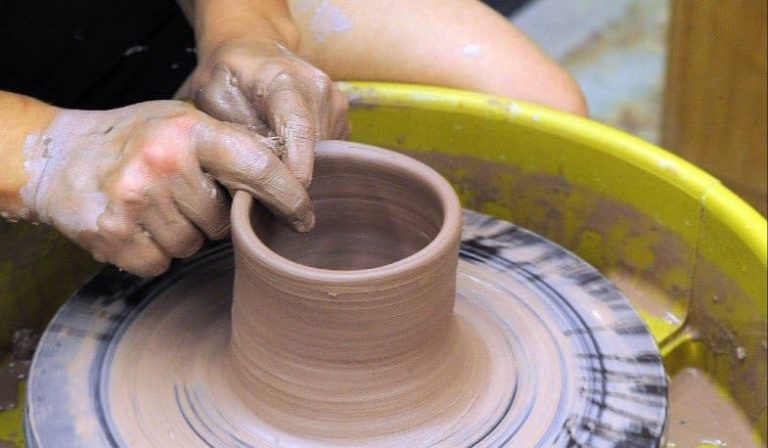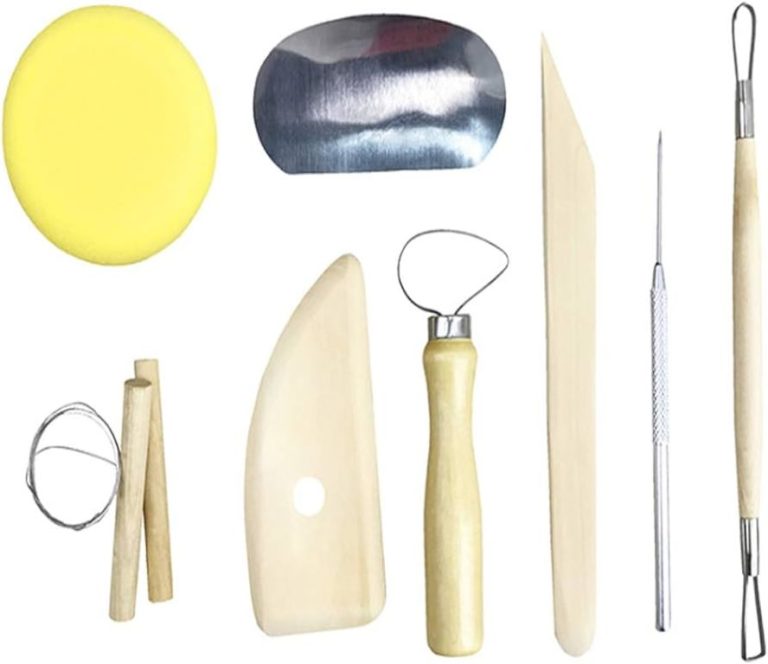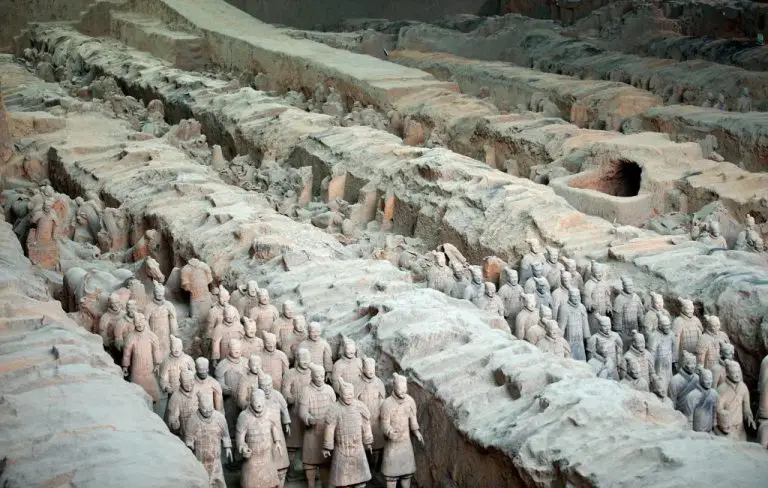What Is Anubis Canopic Jar?
Anubis canopic jars were special jars used by the Ancient Egyptians during the mummification process to hold the organs of the deceased. Anubis, the jackal-headed god associated with mummification and the afterlife, was typically depicted on the lids of these jars.
During mummification, the internal organs of the deceased were removed and embalmed separately from the body. The embalmed heart, lungs, liver, and intestines would be stored in four separate jars with different protective gods depicted on the lids. The Anubis canopic jar held the embalmed intestines and had a lid shaped like the head of Anubis. These jars were then buried alongside the mummy, allowing the organs to be preserved for the afterlife. The four canopic jars together formed a important set within the funerary equipment placed in tombs.
Physical Appearance
Anubis canopic jars were made of either Egyptian alabaster or clay. They were shaped in the form of the head of Anubis, the jackal-headed ancient Egyptian god of mummification and the afterlife. The jars were tapered at the bottom and had a removable lid at the top.
The Anubis canopic jars were used to hold the embalmed viscera organs of the deceased during the mummification process. Since Anubis oversaw the mummification ritual, the jars were shaped to depict his animal head. This gave spiritual protection to the organs placed inside the jars.
Religious Significance
Anubis canopic jars were an important part of the ancient Egyptian mummification process. As the ancient Egyptian god of embalming, Anubis oversaw the process of mummifying bodies and preparing them for the afterlife. During mummification, the internal organs were removed and placed into special jars known as canopic jars. Each jar contained one of the four organs removed from the body – the stomach, intestines, lungs, and liver. The canopic jars allowed these organs to be preserved separately from the body.
Anubis, who was the god associated with cemeteries and embalming, is typically depicted on the lids of the canopic jars. This symbolized his role in guarding and protecting the deceased’s organs in the afterlife. The Anubis canopic jars were placed in the tomb alongside the mummy, surrounded by rituals and prayers to help guide and protect the deceased in their journey to the afterlife. The preservation of the organs in the jars was an essential part of ancient Egyptian beliefs about preserving the body for eternal life.
Set of Four Jars
Anubis canopic jars were always created and used in a set of four jars, with each jar designated to hold one of the four organs removed from the mummy during the embalming process. The four organs included:
- The stomach – Stored in a jar with a jackal head lid representing Duamutef, the son of Anubis.
- The intestines – Stored in a jar with a baboon head lid representing Qebehsenuef, another son of Anubis.
- The lungs – Stored in a jar with a falcon head lid representing Horus, an ancient deity.
- The liver – Stored in a jar with a human head lid representing Imsety, a protector god.
Each jar was topped with a different head meant to protect the specific organ inside. The four sons of Horus were believed to guard these organs which were essential for navigating challenges in the afterlife. Having the entire set of four canopic jars present in the tomb was critical for successful mummification.
Archaeological Examples
Some of the best preserved examples of canopic jars come from the tomb of the famous pharaoh King Tutankhamun. When Howard Carter discovered King Tut’s tomb in 1922, he found four beautifully decorated jars that once contained the pharaoh’s preserved organs. Each jar was intricately carved and painted to represent one of the four sons of the god Horus. The lids were fashioned into the heads of the four sons: human, baboon, falcon, and jackal.
These canopic jars were buried alongside King Tut’s heavily ornamented sarcophagus, as the ancient Egyptians believed the preserved organs would be needed in the afterlife. During the mummification process, the organs were removed from the body and individually embalmed before being placed in their respective jars. The full set of jars was then entombed with the wrapped mummy, demonstrating their integral role in Egyptian burial practices.
Many other lavishly decorated canopic jars have been discovered accompanying mummies in ancient Egyptian tombs. Their presence reflects the importance of preservation of the body and journey to the afterlife in Egyptian culture and religion.
In Egyptian Mythology
Anubis was an ancient Egyptian deity associated strongly with the afterlife, cemeteries, embalming, and funerary rituals. He is typically depicted as a jackal-headed god or as a jackal. Anubis was the son of Nephthys and Osiris.
As a funerary god, Anubis was linked to the process of mummifying bodies and guiding souls into the afterlife. Priests would wear Anubis masks during the mummification rituals. His purview covered the preservation of bodies after death and overseeing cemeteries. Anubis would determine whether souls entering the afterlife were worthy through the weighing of their hearts on his scales.
Anubis was believed to have embalmed the corpse of Osiris after he was murdered by his brother Set. This established Anubis as the patron god of embalmers. He helped preserve Osiris so he could become the ruler of the underworld. Anubis also assisted Isis in reviving Osiris briefly so she could conceive a child with him.
Overall, Anubis played a pivotal role in Egyptian ideas about the journey of the soul in the afterlife. His protection of graves, embalming rituals, and judgement of souls in the Hall of Maat were all essential to Ancient Egyptians’ beliefs about death and the possibility of an eternal afterlife.
In Egyptian Art
Anubis was commonly depicted in ancient Egyptian art as a jackal or a jackal-headed man. The jackal represented Anubis’s roles as a protector of cemeteries and a guide of souls in the afterlife. Images of Anubis as a jackal were engraved on the walls of tombs, painted on papyrus, and crafted into amulets to provide protection for the deceased.
Papyrus paintings from the New Kingdom period (around 1550–1070 BCE) frequently showed Anubis overseeing the process of mummification. These paintings depict Anubis tending to the deceased’s body – removing internal organs, treating the body with preservatives, wrapping it in linens, and more. Anubis is shown dressed in a panther or jackal skin while performing the rituals of mummification. Other tomb paintings show Anubis tests and guides souls on their journey to the afterlife.
Modern Symbolism
Anubis canopic jars continue to hold meaning in modern times as symbolic representations of the afterlife and protection of the dead. While the actual canopic jars were collected and preserved from ancient Egyptian tombs as artifacts, their imagery and symbolism still resonate today. The jackal-headed figure of Anubis watched over the deceased in ancient times, and depictions of the god on canopic jars evoke a sense of that enduring protection and care for the dead into the afterlife.
Anubis was the ancient Egyptian god associated with mummification and the afterlife. Having his image on one of the four canopic jars speaks to how ancient Egyptians hoped Anubis would safeguard the organs placed in the jar on the journey into the next world. So today, reproductions or artistic renderings of Anubis canopic jars carry that same meaning of protecting and guiding the deceased into the afterlife. The iconic imagery connects past and present views of death and the symbolic protection of the dead.
Notable Collections
Some of the most well-known Anubis canopic jars are housed in major museums around the world.
The British Museum in London has several fine examples of these jars in its Ancient Egypt collection. One set dates from the 19th dynasty during the New Kingdom period. The jars have the heads of sons of Horus and are made of calcite.
The Louvre in Paris contains many Anubis canopic jars, including a set made of travertine dating to the 22nd dynasty. The jackal head lids are exquisitely carved and painted.
The Egyptian Museum in Cairo is home to Anubis canopic jars from numerous time periods of ancient Egypt. Highlights include jars from the tomb of Tutankhamun and a 26th dynasty set made of blue faience with black jackal heads.
Intact sets of canopic jars have also been discovered in royal tombs in the Valley of the Kings by archaeologists. When found in undisturbed tombs, the jars often still contain the mummified internal organs of their owner inside.
Conclusion
In summary, Anubis canopic jars were one of the four containers used to separately hold the organs of mummified ancient Egyptians. Anubis, the god of embalming and the afterlife, was depicted on the lids of the canopic jars that contained the stomach. His image took the form of a jackal or dog, honoring Anubis’ role in protecting the deceased in their journey to the afterlife.
Along with the other canopic jars, the Anubis jars held great religious meaning in Egyptian rituals. They were intricately decorated and placed in tombs alongside the mummy, filled with the organs removed during mummification. Archaeologists have discovered many stunning examples of Anubis canopic jars, showcasing Egyptian artistry and beliefs.
Anubis canopic jars remain an iconic symbol of ancient Egypt, representing the preservation of life after death. Their depiction of Anubis continues to capture the imagination today, reminding us of the Egyptians’ devoted efforts to prepare the deceased for eternal life.



